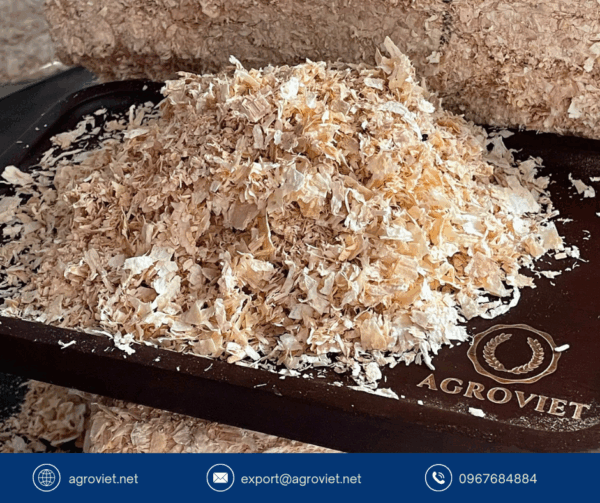How to Make a Biological Bedding with Wood Shavings for Poultry Farming: A Step-by-Step Guide
Step 1: Preparing the Microbial Culture for Wood Shavings Bedding
The success of biological bedding with wood shavings begins with preparing a robust microbial culture to drive decomposition. Start by mixing 1 kilogram of a biological starter culture, such as VBio’s microbial product, with 5 to 7 kilograms of cornmeal or rice bran. Add 2.5 to 3.2 liters of clean water, blending thoroughly to achieve a uniform consistency. Place the mixture in a sealed container or bag and store it in a warm, dry environment for 2 to 3 days to ferment. In colder seasons, maintain warmth to ensure microbial activity remains robust.
This preparation, completed 2 to 3 days before setting up the wood shavings bedding, activates the microorganisms that will break down poultry waste, reducing odors and pathogens. The microbial culture is essential for enabling wood shavings to serve as an effective, sustainable bedding material.
Step 2: Setting Up the Wood Shavings Bedding Base
The foundation of the biological bedding system is a well-prepared base layer, prominently featuring wood shavings. Spread a layer of wood shavings, preferably from pine or acacia, across the poultry house floor to a thickness of about 20 centimeters. Alternatively, create a layered base by spreading 10 centimeters of rice husks, followed by 10 centimeters of wood shavings. The wood shavings should have a moisture content of approximately 20%, achieved by lightly misting clean water with a spray nozzle. To test moisture, grab a handful of wood shavings; they should feel damp but remain loose, not clumping. If too dry, mist additional water and rake gently for even distribution.
This wood shavings base creates an ideal environment for microbial activity, ensuring effective waste decomposition and a clean poultry house.
Step 3: Applying the Microbial Culture to Wood Shavings
With the wood shavings base prepared, the next step is to apply the microbial culture to initiate fermentation. Evenly spread 5 kilograms of the pre-fermented cornmeal or rice bran and microbial culture mixture across the wood shavings surface. Then, use a sprayer to distribute 2.5 to 3.2 liters of the liquid microbial culture over the wood shavings, ensuring thorough coverage. Sprinkle any remaining solid residue from the culture mixture on top. Gently rake or hand-mix the wood shavings to integrate the culture fully, allowing microorganisms to penetrate the bedding material.
This step ensures that the wood shavings are primed to break down poultry manure efficiently, maintaining a hygienic and odor-free environment as soon as chickens are introduced.
Step 4: Fermenting the Wood Shavings Bedding
After applying the microbial culture, cover the wood shavings bedding with a plastic tarp or nylon sheet to create an airtight environment that promotes fermentation. Allow the bedding to ferment for 2 to 3 days, until it feels warm to the touch, signaling active microbial decomposition within the wood shavings. This warmth indicates that the microorganisms are effectively breaking down organic material, preparing the bedding for poultry use. Once fermentation is complete, remove the tarp and rake the wood shavings to a depth of about 20 centimeters to aerate the bedding.
Aeration prevents compacting, keeping the wood shavings loose and effective. The bedding is now ready for chickens, provided the poultry house remains well-ventilated and protected from rain to preserve the wood shavings’ functionality.
Step 5: Maintaining the Wood Shavings Bedding
Ongoing maintenance is crucial to ensure the wood shavings bedding remains effective. After introducing chickens, regularly monitor the wood shavings surface. For chicks in the brooding phase, check after 7 to 10 days; for meat chickens, inspect after 2 to 3 days.
When manure accumulates, lightly rake the top layer of wood shavings to keep it loose and aerated, allowing microorganisms to continue decomposing waste. If the wood shavings become compacted or develop a slight odor, rake more thoroughly and consider adding a small amount of additional microbial culture to refresh the system. Prevent water from drinking systems or rain from wetting the wood shavings, as excess moisture can disrupt microbial activity. With regular raking every 1 to 2 days, the wood shavings bedding can remain effective for 6 months to a year.
Benefits of Wood Shavings in Biological Bedding
Using wood shavings in biological bedding offers significant advantages for poultry farming. The combination of wood shavings, rice husks, and microbial cultures creates a system that naturally decomposes manure, reducing harmful gases like ammonia and hydrogen sulfide. This results in a cleaner, healthier environment for poultry and farmers.
Wood shavings, particularly from pine or acacia, enhance absorbency and durability, reducing the need for frequent cleaning and saving labor and water. The bedding’s longevity, lasting up to a year with proper care, makes it cost-effective. Additionally, wood shavings are biodegradable, and used bedding can be composted as fertilizer, supporting sustainable farming. By incorporating wood shavings, farmers create an eco-friendly, efficient bedding system that improves animal welfare and farm sustainability.
